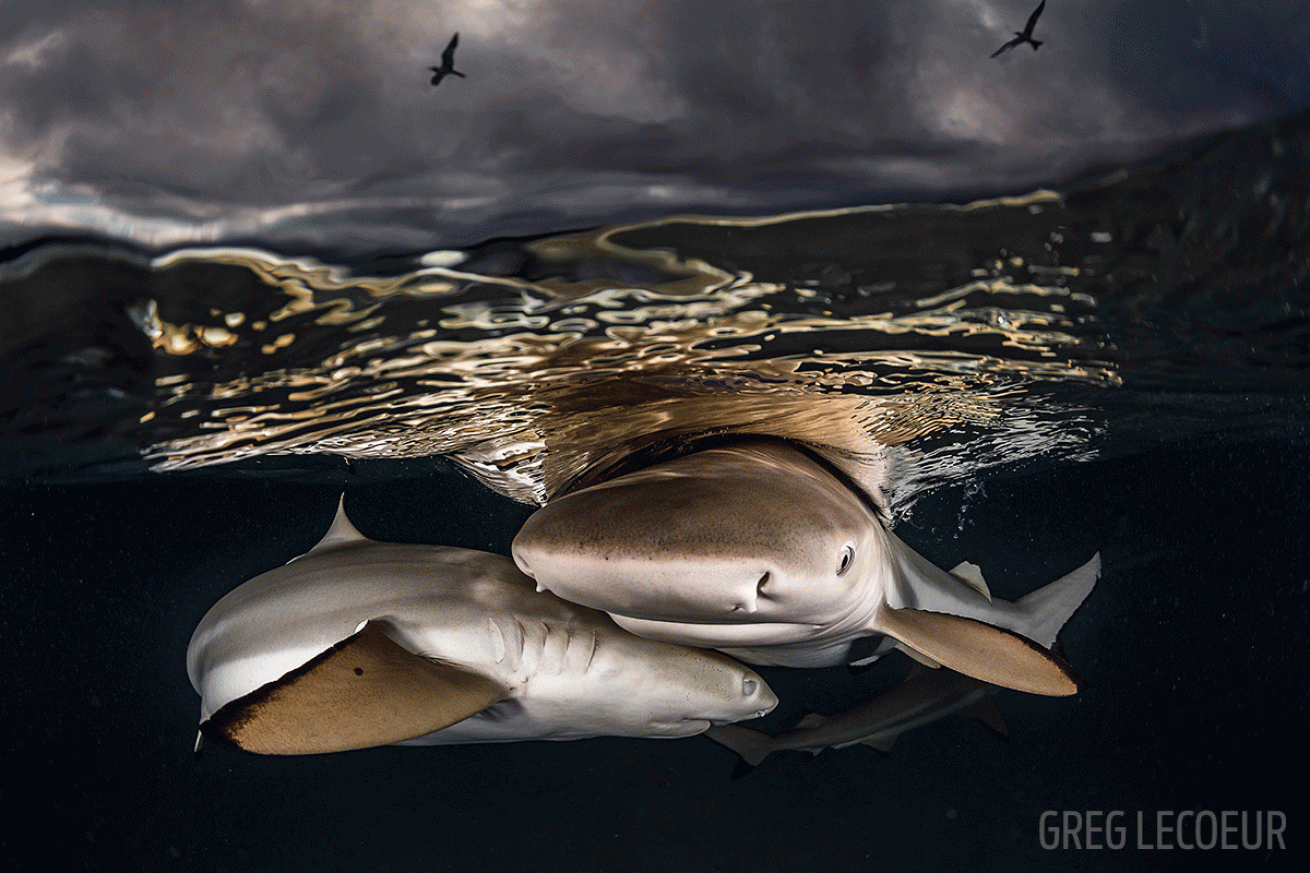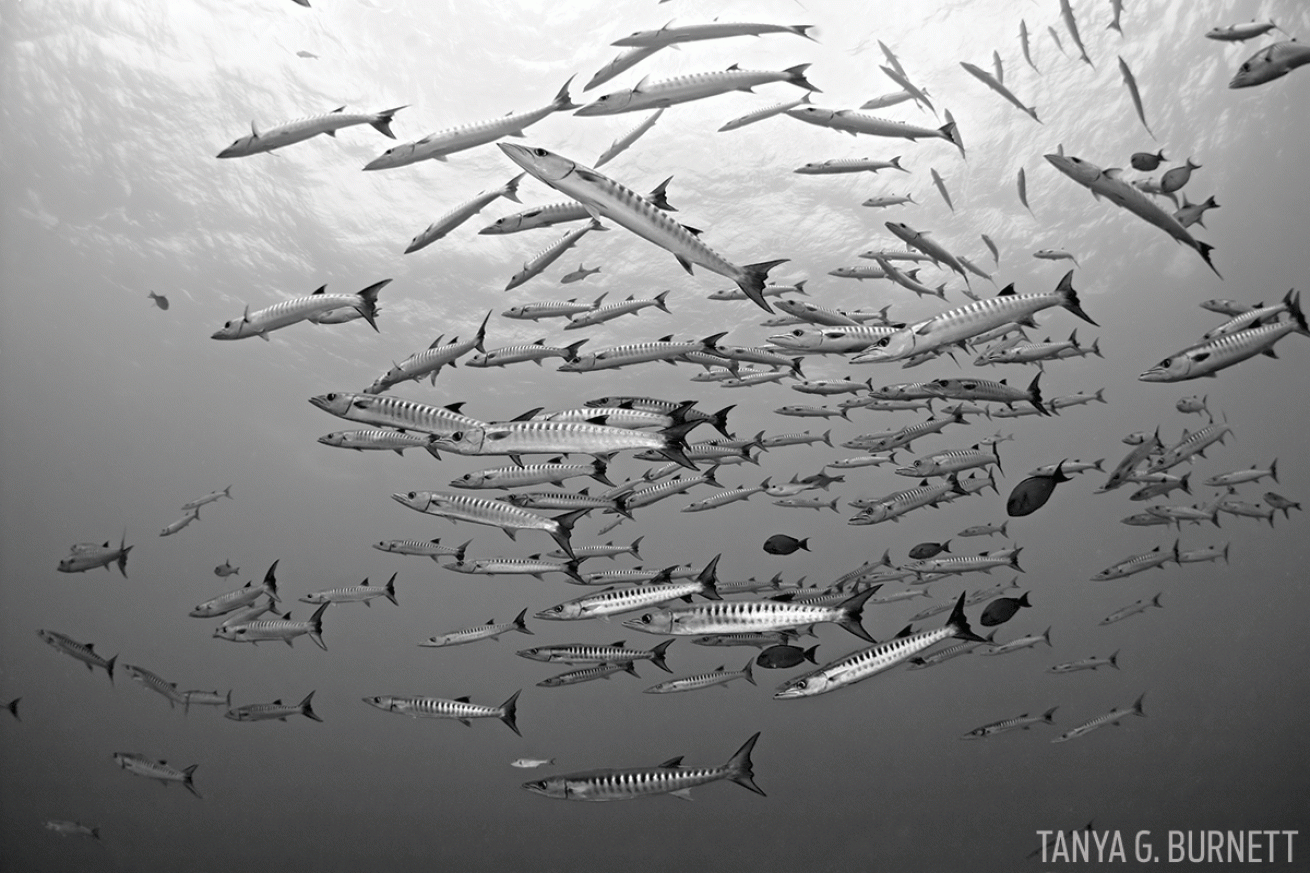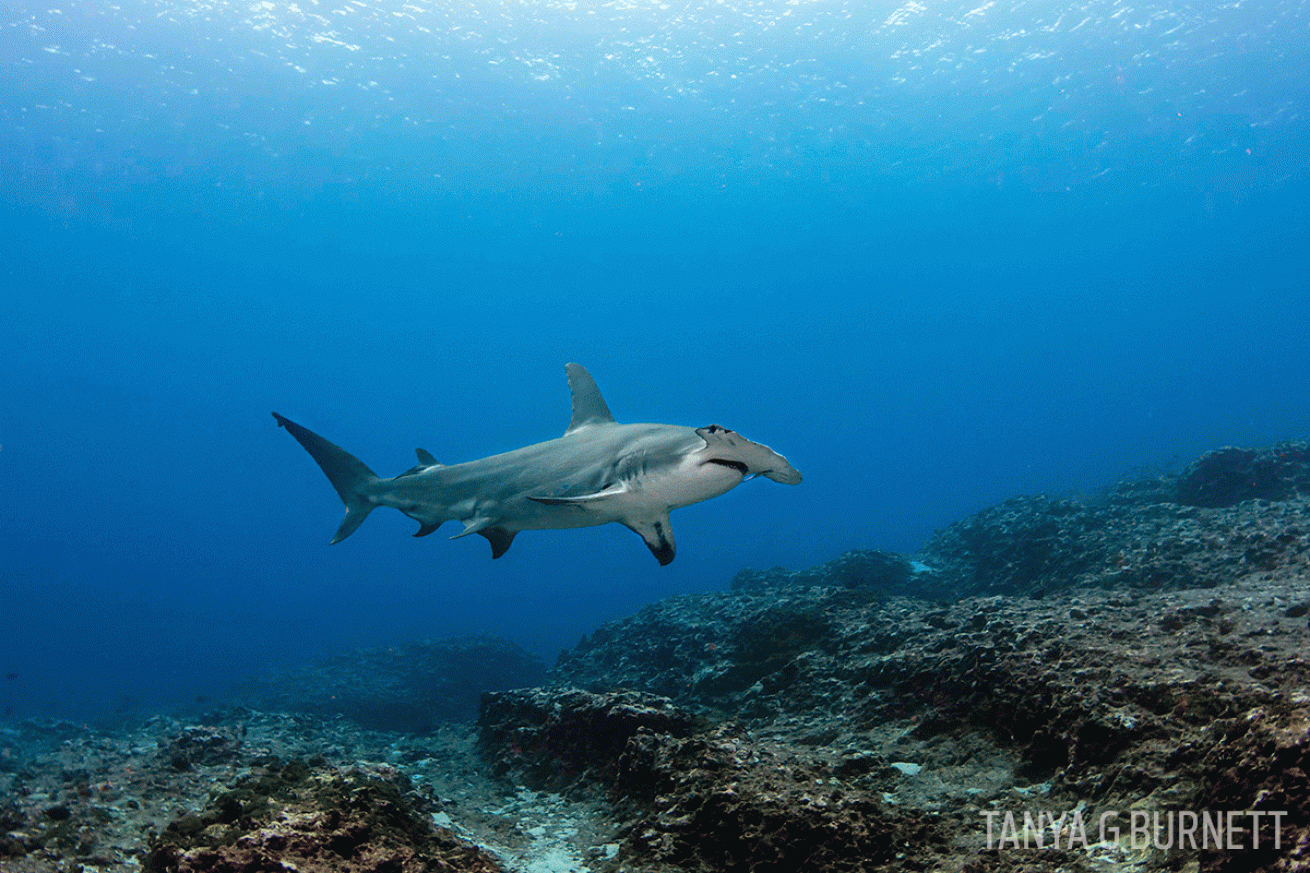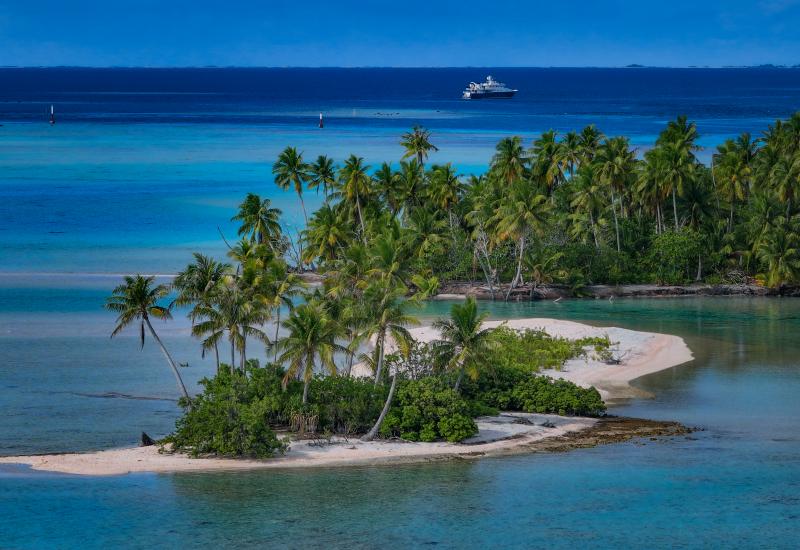The Best Diving in the Islands of Tahiti

Greg LecoeurA Sea of Sharks
A diver has a ringside seat for the shark show that is Fakarava's storied south pass, in the Tuamotu atoll.
I’ve got a surprise for you,” our divemaster says, “at the end of the second dive.” The islands of Tahiti have been one surprise after another, so I’m guessing it’s some kind of delicacy, perhaps another variation on poisson cru, the signature local dish of raw fish, citrus juice and coconut milk. French Polynesian hospitality lives up to its reputation, so a little more pampering isn’t much of a shock.
The biggest surprise on this day is simply getting to Fakarava’s storied Tamakohua Pass. A week of torrential rain has lifted just enough to make the run from Pearl Havaiki Fakarava Lodge and pearl farm on the atoll’s northeast side to Tetamanu, the motu, or islet, at the south pass. We’re jolted along for a bumpy, spray-soaked 75 minutes, squatting on our dive gear in borrowed slickers. But our smiles belie the discomfort — there’s not a diver on this RIB who’s not excited to experience Tamakohua.
The briefing is simple. “Stay on the left, and open your eyes and look.”

Greg LecoeurJust the Tip of the Iceberg
Blacktip sharks are a common sight in Tuamoto lagoons — and in open water.
We drop just outside the pass, off the southeast wall. It’s an amphitheater of sharks — mostly young silvertips, too many to count, fins in motion in every direction: up, down, side-to-side — with a gang of barracuda hanging above. We enter and cross to the west, with a few gray sharks following. It’s a spectacularly pretty pass, with healthy hard coral of all description and every sort of reef fish found in the Tuamotu archipelago: black and white dascyllus, saddle and double saddle butterfly fish, clouds of purple anthias, and more.
After a surface interval snorkeling Tetamanu’s shallows — picturesque corals, blacktips, and humphead wrasse so giant they have to swim sideways — we’re back for round two, and wondering about that surprise.
We drop in the center of the pass, and keep to the east where the current is much stronger. This time we’re hunkered down at eye level with dozens of sharks, some coming in close as they rise and fall on the current. We change positions a few times, easing down the pass, reluctant to let go. But at last we must fly.
Approaching the mouth of the lagoon at dive’s end, we’re startled to come upon an eerie wasteland, a huge bowl paved with gravelly bits of dead coral.
Bam! Suddenly there are sharks everywhere. We are no longer spectators; we are right in their midst, one with their kind. Everyone backpedals hard, trying to extend the moment, but the current can’t be denied. We regroup in the lagoon to laughter and cheers, and head for a picnic on a nearby pink-sand beach, as satisfied as divers can be.

Tanya G. BurnettA Battery of Barracuda
Tikehau holds a variety of fish including barracuda, blacktips, eagles rays, and trigger fish.
South Sea Dreams
Call it the Tahiti effect. The romance of these 118 islands — grouped in five distinct archipelagos from coral atolls to forested volcanoes — is so overpowering that even the national tourism agency is eager to have journalists write about something else. For centuries, Tahiti and its islands have cast such a spell that virtually no one who makes it here wants to leave. (Today Air Tahiti Nui and local carrier Air Tahiti make voyages from LAX and interisland flights extremely simple; both are diver-friendly.)
But there’s another allure for divers: sharks, revered as gods in Polynesian mythology. We start our search on über-romantic (sorry!) Tikehau, where small blacktips meander like house cats below over-water bungalows at Tikehau Pearl Beach Resort. What this remote island in the Tuamotu atoll offers, says general manager Anne Tran-Thang, is time: “Time to appreciate everything.” It’s a philosophy embraced by the laid-back Tahitians. Aita pe’ a pe’ a’ — “no worries” — is the answer to virtually all requests.
The next day, we drop on the fishy north side of Tuheiava Pass, on top of a pair of mating eagle rays. Gigantic triggerfish — Picasso, titan, redtooth — bare impressive teeth as we meander along a small wall where a pink frogfish the size of a beach ball entertains us. Moving into the current, we finally spy a shark wedged under a ledge, a whitetip that pays us no mind.
Next dive, we try again, on the opposite side of the pass, and are treated to more eagle rays. Again, no sharks. But we’re not worried. Rangiroa is coming….
The Rangiroa Express
“If you hurry, you can make the 10 a.m. dive.” I’m thinking this is crazy talk, since we’ve just arrived at Rangiroa’s airport on the 9:40 flight, where by chance we’ve run into a Top Dive instructor based at our hotel, luxurious Kia Ora Resort & Spa. But, no worries — all things are possible in the islands of Tahiti. After a mad scramble to unpack dive gear in the resort’s soaring open-air lobby, we’re on the dock and ready to go.
This time, the shark gods are with us. On our first run through Tiputa Pass, we get a glimpse of a hammerhead over a small ridge. Not big, not close, but a hammer. Oh, well, I think, every shark can’t be a colossus.
Then out of the corner of my eye, I catch movement. Rolling like a freight train — smooth, purposeful, unstoppable — is a 14-foot female great hammerhead. She motors past like we’re not there, maybe 25 feet away, one giant muscle with a strangely tiny head. Even the divemasters are slack-jawed in amazement — in 800 dives on Rangiroa, our guide has seen great hammers only a dozen times, and usually much deeper than our 50 or 60 feet. “A hammer in shallow water is very lucky,” he says later.

Tanya G. BurnettGreat Hammerhead
Sharks are revered as gods in Polynesian mythology, and encountering a 14-foot great hammerhead makes it easy to see why.
A Tiputa briefing is its own adventure: Stay outside the pass and wait for the divemaster’s signal. Stay low, about 90 feet, and never mind your deco alarm — enter too high and the current will push you even higher, where you’ll miss the dive. Inside the pass, watch for “the Canyon,” a current-less trench where nimble divers tuck in and watch the passing show — miss it, and roaring Tiputa becomes a very short dive. Exit together on the divemaster’s count. If you lose the group, make bubbles; the tender captain will find you.
The drop is not far offshore, yet you feel you are out in the blue, with 200 feet of viz or more. Hundreds of animals move across the moonscape of the Tahitian seafloor: sharks, eagle rays, tuna and barracuda. Vistas appear so wide it’s as if you’re observing the curvature of the Earth.
Next drop, our DM rolls a plastic bottle between his palms, and gray sharks quickly converge. In minutes I count more than 100, with even more barracuda overhead. Every now and again a shark makes a feint at one of us, but it’s all for show — apparently the sharks, mostly juveniles, find us good entertainment. It’s mutual.
Finning across the undersea plains, you feel an almost imperceptible pull that becomes urgent, then insistent, then irresistible: the call of Tiputa. Once you commit, it’s like strapping into your favorite theme-park ride: no turning back.
But Tiputa isn’t about the landscape. It’s all about your fellow travelers, which can be just about anything. We tuck into the Canyon, where a fever of eagle rays passes overhead, followed by backward-somersaulting divers who give us a laugh. It all ends in the shallows on the east side, where any deco time passes quickly, fish-spotting the little beauties of the South Seas.

Greg LecoeurTouch Me
Well-known by the locals this friendly dolphin — affectionately referred to as Touch Me — habitually presents her calves to divers.
Touch Me and Her Kin
If you’re a diver who feels strongly about not touching wildlife, this might be a good place to turn the page.
We’ve spent a blue-water dive or two looking for dolphins. A few bomb through now and again, lightning-fast bundles of nervous, squeaky curiosity, but encounters are elusive, and brief.
On our last day, we try once more. Almost immediately, a female and large calf appear at the surface and head down to check us out. Unbelievably, the mother appears to be pushing the baby toward us. The calf rolls on its back, displaying a creamy tummy to divers practically quivering with excitement. The next thing we know, the mother also is lying on her back, an invitation to play that we joyfully accept.
The love fest goes on for minutes, the mother waiting until each diver has a chance to say hello. Later our divemaster tells us she is well-known to locals. “We call her Touch Me,” he says with a smile. She habitually presents her calves to divers — something the rest of her pod does not do.
Check out our video of the incredible encounter.
Soon enough it’s time for them to surface; a large male appears and greets both with a touch of the rostrum. He’s not alone — framed against the morning sun are two more females, each with calves. Watching the pod depart to rejoin the great pulsing circle of life in this wild place, we again feel an immense sense of satisfaction. Happy ever after indeed.

Tanya G. BurnettFakarava Finale
Divers end their Fakarava adventure in picturesque shallows.
What It Takes
The most thrilling diving in the Tuamotu chain — which includes Tikehau, Rangiroa and Fakarava — is all pass diving, at speeds up to about 4 knots. (Currents can be stronger, up to 8 knots, but some operators will not run the passes with guests at higher speeds.) Good control of buoyancy is key on these sometimes-bumpy rides. In waters as clear as Tahiti’s, paying attention to depth also is a requirement, particularly if you are diving nitrox, as most divers here are. Knowing how to use your computer and understanding what it is telling you are important, but so is a willingness to put up with a small amount of deco time, which passes pleasantly in relative shallows rife with reef fish of all kinds. You should be comfortable deploying your SMB at depth — you also should be comfortable with the presence of large predators, often in great numbers and on every dive.
Need To Know
When to Go: The islands of Tahiti are a year-round destination, but high season, which runs from May to October, brings higher prices.
Dive Conditions: The Tuamotu Islands — Tahiti’s best-known dive islands — have the most favorable conditions April through November. Water temps range from 79 degrees F in the winter to 84 in summer; a 2- or 3-mm full wetsuit is sufficient. Visibility regularly ranges from 100 feet to much greater.
Operator, Accommodations and Travel: Top Dive , with 12 locations on seven islands, including Rangiroa, Fakarava and Tikehau; Tikehau Pearl Beach Resort , Tikehau; Hotel Kia Ora Resort & Spa, Rangiroa; Pearl Havaiki Fakarava Lodge; Air Tahiti Nui , for flights from the U.S. and Europe; Air Tahiti , inter-island flights










